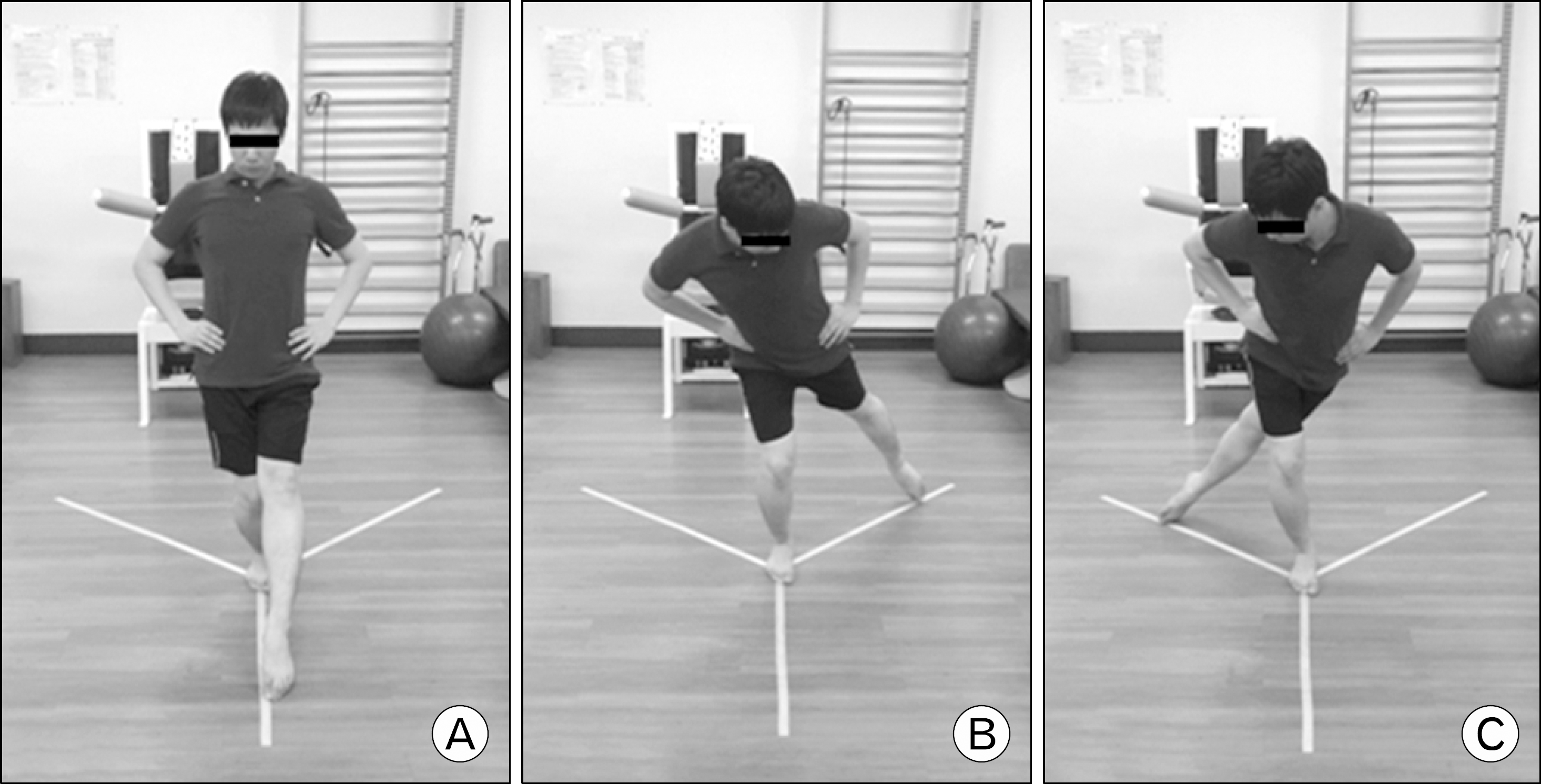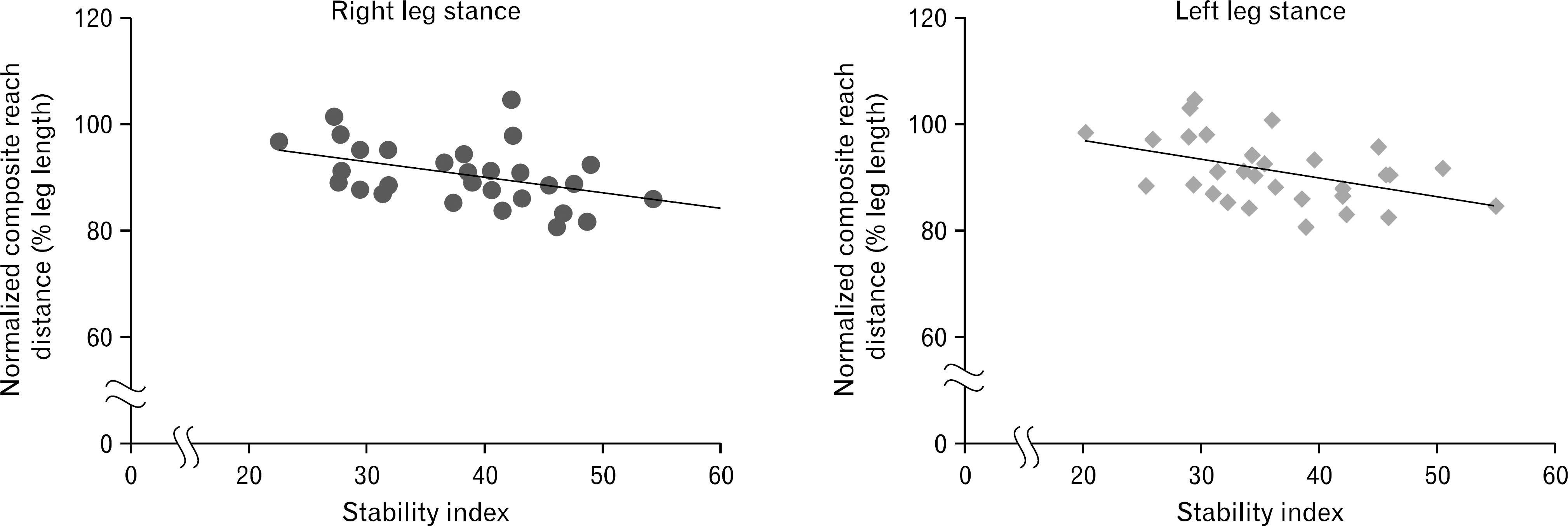Abstract
Posturographic examination is commonly used by clinicians to evaluate standing balance. Because it is perfomed with double leg standing, it cannot sensitively detect the minor balance problem like functional ankle instability. This study aims to evaluate the test retest reliability of the single leg balance test using Tetrax posturography and its correlation with modified star excursion balance test (mSEBT). 30 healthy participants (16 male, 14 female, mean age 26.3±3.3) were volunteered for this study. We manufactured a specially designed wood plate to assess their single leg standing balance. It was set on each of the 4 force plates of Tetrax posturography (Sunlight Medical Ltd., Ramat Gan, Israel). Stability index were measured based on each single leg stance. Participants performed the single leg balance test on Tetrax posturography in three different times, and they also performed the mSEBT. The test retest reliability of stability index measured by Tetrax posturography was assessed by the intraclass correlation coefficient, and its correlation with the normalized composite distance of mSEBT was assessed by Pearson correlation coefficient. The single leg balance test using Tetrax posturography showed good test retest reliability. There was a negative correlation between the stability index of Tetrax posturography and the normalized composite distance of mSEBT, based on right and left leg stance, respectively. These findings suggest that Tetrax posturography is a useful and reliable tool for single leg balance assessment.
Go to : 
REFERENCES
1. Hertel J. Functional anatomy, pathomechanics, and pathophy-siology of lateral ankle instability. J Athl Train. 2002; 37:364–75.
2. Freeman MA, Dean MR, Hanham IW. The etiology and prevention of functional instability of the foot. J Bone Joint Surg Br. 1965; 47:678–85.

3. Tropp H. Commentary: functional ankle instability revisited. J Athl Train. 2002; 37:512–5.
4. Kim HM, Chun MH, Kim CR, Park JY. Effects of dynamic ankle-foot orthosis on postural balance control in hemiparetic patients. J Korean Acad Rehabil Med. 2011; 35:188–94.
5. Kim BR, Choi KH, Chun MH, Lee MC, Chung SJ, Jang KW. Evaluation of balance control in patients with idiopathic parkinson's disease using tetra-ataxiometric posturography. J Korean Acad Rehabil Med. 2009; 33:538–46.
6. Lee GE, Bae H, Yoon TS, Kim JS, Yi TI, Park JS. Factors that influence quiet standing balance of patients with incomplete cervical spinal cord injuries. Ann Rehabil Med. 2012; 36:530–7.

7. Oppenheim U, Kohen-Raz R, Alex D, Kohen-Raz A, Azarya M. Postural characteristics of diabetic neuropathy. Diabetes Care. 1999; 22:328–32.

8. Kohen-Raz R. Application of tetra-ataxiametric posturography in clinical and developmental diagnosis. Percept Mot Skills. 1991; 73:635–56.

9. Hertel J, Braham RA, Hale SA, Olmsted-Kramer LC. Simpli-fying the star excursion balance test: analyses of subjects with and without chronic ankle instability. J Orthop Sports Phys Ther. 2006; 36:131–7.

10. Plisky PJ, Rauh MJ, Kaminski TW, Underwood FB. Star excursion balance test as a predictor of lower extremity injury in high school basketball players. J Orthop Sports Phys Ther. 2006; 36:911–9.

11. Hertel J. Sensorimotor deficits with ankle sprains and chronic ankle instability. Clin Sports Med. 2008; 27:353–70.

12. Robinson RH, Gribble PA. Support for a reduction in the number of trials needed for the star excursion balance test. Arch Phys Med Rehabil. 2008; 89:364–70.

13. Munn J, Sullivan SJ, Schneiders AG. Evidence of sensorimotor deficits in functional ankle instability: a systematic review with metaanalysis. J Sci Med Sport. 2010; 13:2–12.

14. Olmsted LC, Carcia CR, Hertel J, Shultz SJ. Efficacy of the star excursion balance tests in detecting reach deficits in subjects with chronic ankle instability. J Athl Train. 2002; 37:501–6.
Go to : 
 | Fig. 1.(A) Tetrax posturography is composed of monitor, desk-top and four separate force plates. (B) Specially manufactured wood plate which in-stalled on each of the four force plates. (C) Performing the single leg balance test. (D) Bottom surface of the wood plate. |
 | Fig. 2.(A) Anterior, (B) Poster-omedial, (C) Posterolateral reach directions of the modified star excursion balance test based on right leg stance. |
 | Fig. 3.Statistically significant (p<0.05) and negative correlation was observed between the stability index of Tetrax posturography and the normalized composite distance of modified star excursion balance test, based on right and left leg stance, respectively. |




 PDF
PDF ePub
ePub Citation
Citation Print
Print


 XML Download
XML Download